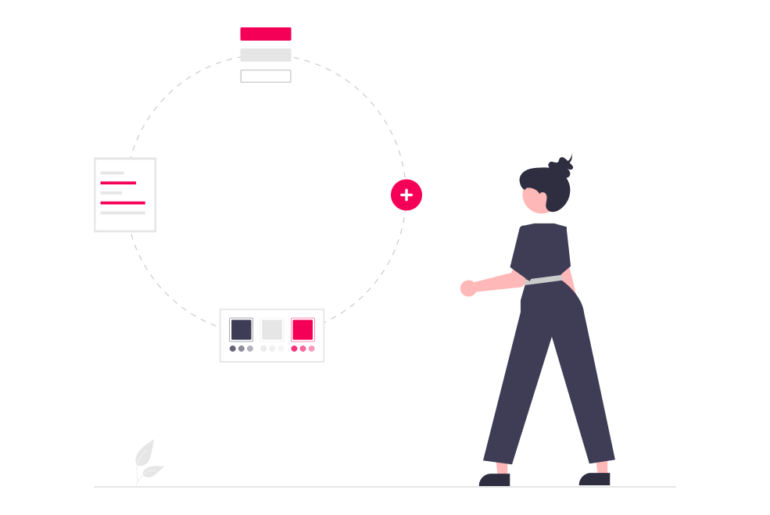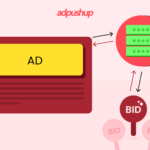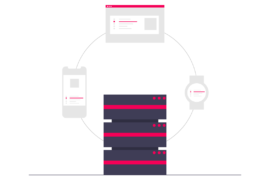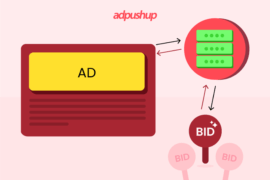Still trying to figure out what Header Bidding Wrapper is? The Header Bidding Wrapper is a single-line JavaScript code that allows publishers to manage multiple demand partners. Check out this blog to learn everything you need to know about header bidding wrappers, how they work, how to optimize them, etc.
Header bidding has become a gold standard for increasing ad revenue for many publishers. While header bidding can help publishers increase the competition for their ad inventory, few recognize the importance of header bidding wrappers in optimizing performance, managing complexity, and ensuring a seamless auction process.
In this blog, we’ll explain how header bidding wrappers function behind the scenes. From the types of different header bidding wrappers to how to choose the best one, we have dived into the crucial details you need to know.
What is a Header Bidding Wrapper? (Header Bidding Definition)
A header bidding wrapper is a JavaScript code that resides on a publisher’s webpage. It allows publishers to manage multiple demand partners using a single code.
The wrapper ensures that all demand partners receive bid requests simultaneously and enforces timeout settings, determining how long the browser waits for bidder responses. In short, wrappers streamline header bidding implementation.
Based on their function, header bidding wrappers can be categorized as:
- Client-side
- Server-side
- Hybrid
Depending on who built them, they can be:
- Open-source
- Proprietary
- Managed solutions
That being said, let’s now have a look at how does header bidding wrapper work.
How Do Header Bidding Wrappers Work?
Header bidding wrappers simplify the process of integrating multiple demand partners. Instead of adding and managing individual demand partner codes, a wrapper allows publishers to add or remove partners.
Wrappers can also contain ad tag codes for services such as tracking, analytics, and viewability that are to be run on publisher pages. Their primary function is to generate bid requests, collect bids, and communicate them to the ad server.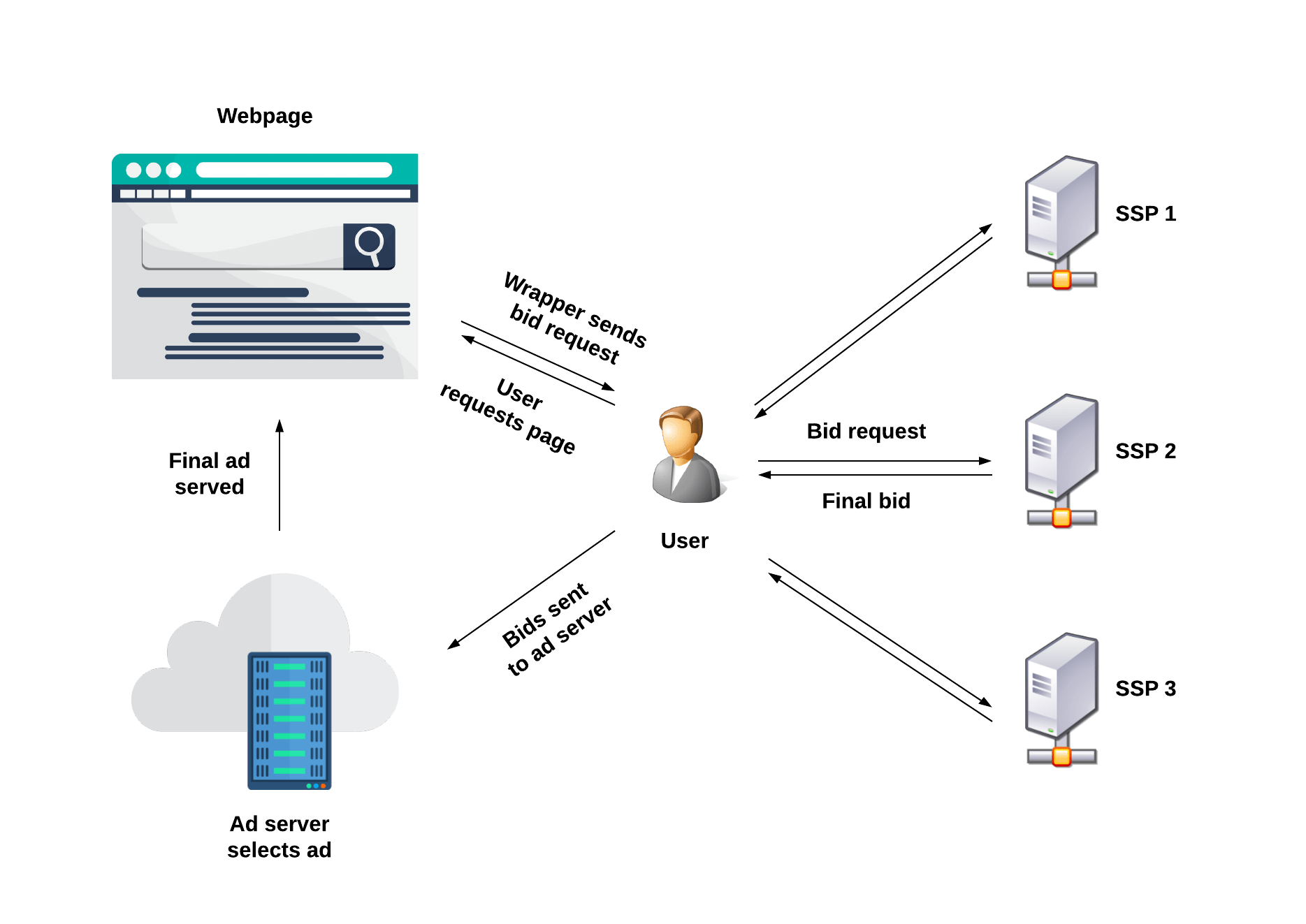
Generally speaking, these are the steps involved in how that process works:
- The user requests the webpage
- Demand partners respond with their bids
- Wrapper sends the collected bids to an ad server (such as Google Ad Manager)
- The ad server makes its final decision and serves the ad
Wrappers function similarly to tag management tools, which makes it easier for publishers to handle multiple demand sources efficiently.
What are The Types of Header Bidding Wrappers?
There are two primary benefits of using a wrapper: maximizing revenue through a fair auction and reducing latency by optimizing each exchange adapter.
There are three main types of header bidding wrappers:
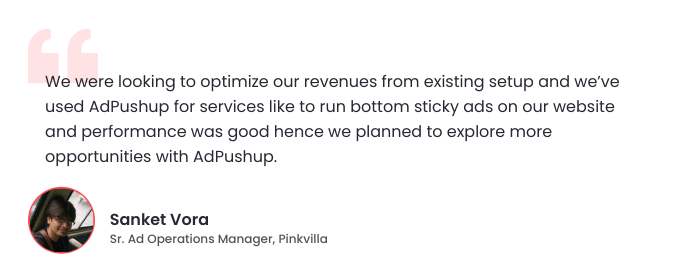
1. Open-source Header Bidding Wrapper
Open-source wrappers are free and accessible to all. Being open-source code means it is open to the community, thus, there is more transparency as it can be accessed by them to ensure a fair auction.
The most famous open-source header bidding is Prebid.js. Over 1,00,000 websites are currently using Prebid wrappers, including many large publishers like Vogue, Business Insider, Forbes, etc.
Advantages:
- Greater flexibility and customization
- Transparency in auctions
- Cost-effective for publishers
Other commonly used open-source solutions include Prebid
Before you go further:
Read how AdPushup’s Header Bidding solution helped All Garage Floors achieve a 1.8X revenue uplift.
2. Proprietary Wrapper Solution
As opposed to open-source, proprietary solutions have to work with individual exchanges. Proprietary wrappers are offered as a service or a license to publishers in exchange for a certain fee.
There are certain challenges to using a proprietary wrapper, such as:
- Higher costs compared to open-source alternatives
- Limited control over implementation
- Less transparency
3. Managed Wrapper Solutions
Publishers who are not well-versed with the technical resources, SSP partnerships and, ad operations might want to opt for the managed wrapper solutions.
One of the best things about managed solutions is that Prebid is frequently built on top of them, offering you complete transparency and, depending on the supplier, additional benefits.
Many managed solutions build on Prebid, providing transparency and additional benefits such as:
- Dedicated account managers
- Implementation support
- Centralized dashboard for analytics and monitoring
This makes it easier for publishers to focus on producing quality content without having to worry about the technical aspects of ad operations.
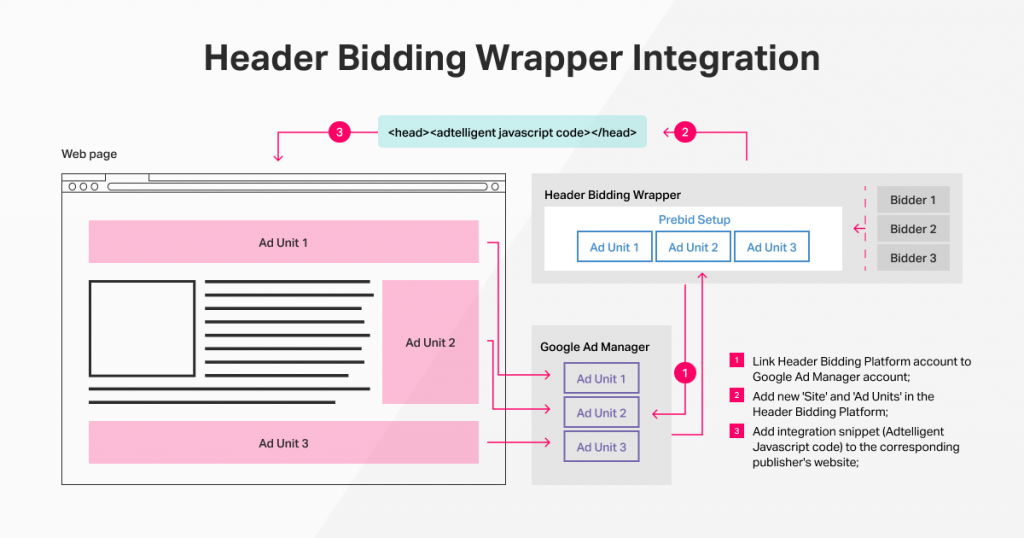
Best ways to Optimize Header Bidding Wrapper
Optimizing your header bidding wrapper can help you by fine-tuning bidder counts, addressing latency issues, and creating a seamless process for you and your demand partners. With the right steps, you can turn your wrapper into a revenue-generating powerhouse.
How? Let’s find out:
Get the correct number of bidders:
Too much of anything is bad. The same goes for the number of bidders. Too many bidders can slow the bidding process, and fewer bidders end up costing more money. So, what is the right number of bidders? You should aim for 5-10 bidders or test out to find your sweet spot where you can reduce latency and boost revenue.
Smart Floor Pricing:
Determining the right floor price plays a significant role in boosting your ad revenue. You can also use AI tools like dynamic flooring to adjust floor prices as per your requirements. By setting up the ideal floor price, you can make sure that only the best deals come your way.
Fallback Bidders:
Real-time bidding is a game for fast pacers; if one bidder doesn’t respond, don’t worry. By Implementing sequential bidder fallback, you can call the next bidders sequentially. This method can help you to sell impressions quickly, reduce latency, and boost your earnings.
Fix network latency:
A slow network is equal to less ad revenue. If you want to avoid network lagging, you must send ad requests to servers closest to the bidders. Eventually, this gives bidders more time to place bids, leading to better CPMs and overall revenue.
With these methods, your header bidding wrapper will become faster, wiser, and more profitable. A little effort will bring out the best in your ad performance.
Advantages of Header Bidding Wrappers
As vital as header bidding is for revenue optimization, setting it up can be a complicated undertaking, and yes, if not done well, it can increase latency. Header bidding wrappers were created to take care of challenges faced by publishers and make the bidding experience more efficient in the following ways.
Optimal timeouts
Some header bidding demand partners allow you to set timeouts, while others don’t. But if you place every partner’s code into a wrapper, you can set a central timeout that will cut off bids from any partner that is too slow to respond.
It’s also easier to manage timeouts from one place, with a wrapper than setting it manually with each demand partner.
Asynchronous code
Since wrappers support asynchronous code, all the bid requests are sent to demand partners simultaneously as soon as the webpage is requested by the user.
In the case of synchronous code, a tag would be fired only after the previous one has finished executing. While the auction is still limited by the slowest partner, there is a queueing-associated delay.
Demand management
Have a demand partner who consistently slows down the auction?
Header bidding wrappers make it easier to add or remove demand partners.
Just drop them from the wrapper. It simplifies work for your ad operations team by giving them a central container to work with instead of having to manage a patchwork of code from multiple demand sources.
Disadvantages of Header Bidding Wrappers
As you can see, there are a lot of advantages to using a wrapper. The advantages far outweigh its downsides, still, you should be aware of the downsides before you decide to get one.
Complex setup
It may take considerable time and effort to understand how the wrapper works, what it supports, and what it doesn’t during the initial setup.
So if you’re just testing header bidding or plan to work with only one demand partner, by all means, give it a miss.
However, if you’re serious and want to maximize revenue by working with multiple demand partners, setting up a wrapper is a long-term investment that will save you much more time and effort later.
Partner stickiness
There are multiple vendors that offer header bidding wrappers now including Prebid, Yieldbot, Index Exchange, OpenX, bRealTime, and Amazon to name a few.
Once you sign up and spend the time setting up a vendor’s wrapper, leaving them at any point will mean that you will have to repeat the process all over again with the new vendor—which is something that may make you resistant to changing your wrapper even if you really need to.
Demand incompatibility
IAB is yet to define a standard for how wrappers should work, what data they should collect, and what they shouldn’t. This makes demand partners nervous because they have reduced control over the data and need to support third-party technology. Therefore, some demand partners may not allow you to run their code within a wrapper.
What to Look for in a Header Bidding Wrapper?
While selecting a vendor, consider your current situation. Do you have a capable ad ops team that is comfortable with setting up and managing the wrapper? If yes, you should probably opt for an open-source vendor with the widest demand partner support.
On the other hand, vendors providing managed wrappers may need fewer inputs in terms of setup. They may also provide value-added services such as analytics and support.
AdPushup provides managed header bidding services to web publishers. Some features that differentiate our solution from competitors include:
- Automatic demand partner selection
- Smart timeout management
- Integration of native demand
- The ability to add your own demand partners
- Bid monitoring and discrepancy resolution
- Multi-ad size support
Sign up for a free demo and 30-minute consultation with our Ad Ops experts
AdPushup’s Header Bidding Solution
Merely deploying header bidding in your ad stack isn’t enough. Consistently optimizing it with technical improvements is the need of the hour.
This is what AdPushup’s header bidding solution does. Through our multiple optimization features using data science and machine learning, we help publishers maximize their yield.
With our header bidding solution, you get:
- Automatic demand partner selection according to optimum requirements
- Smart timeout management
- Freedom to bring your own demand
- Bid monitoring and discrepancy resolution
Read more about our product capability: Header Bidding
Key Takeaways
- Header Bidding Wrappers act as a framework, allowing publishers to manage various demand partners through a single line of code.
- The wrapper facilitates parallel bidding for all demand partners, enabling real-time bidding and a unified auction. Header Bidding Wrappers contrast with the traditional waterfall method, where bids are placed on a sequence basis.
- Wrappers optimize yield through simultaneous bidding, reduce latency, streamline ad operations and offer transparency to publishers, leading to smooth and informative decision-making.
- Header Bidding Wrappers come in three forms: Open-source for customization and community support, Proprietary for vendor-specific features and Managed solutions for simple implementation and better support.
- Overall, the main purpose of a header bidding wrapper is to streamline the header bidding process and provide more control and flexibility for the publisher.
Adpushup’s header bidding solution helps publishers to optimize their ad inventory using AI and machine learning. Through their automatic demand partner selection, smart timeout management, flexible demand integration, and comprehensive bid monitoring, you can get the most out of your ad revenue.
FAQs
Header Bidding Wrappers act as a container or a framework, helping publishers manage multiple demand partners through a simple JavaScript code. Programmatic auctions are organized and governed by this technology.
Header bidding, or advanced bidding, is an advanced programmatic technique in which publishers simultaneously bid on inventory across multiple ad exchanges (mostly DoubleClick for Publishers).
Header bidding offers publishers the greatest yield. Publishers can sell inventory per impression by using header bidding, which allows them to have a simultaneous auction from all bidders.
Publishers need header bidding wrappers to increase the ad yield on their inventory by allowing multiple demand partners to bid on the available ad inventory simultaneously. Using a wrapper allows them to earn higher CPMs and better fill rates.

